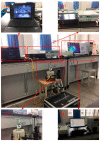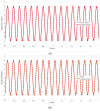A High-Speed Target-Free Vision-Based Sensor for Bus Rapid Transit Viaduct Vibration Measurements Using CMT and ORB Algorithms
- PMID: 28587275
- PMCID: PMC5492359
- DOI: 10.3390/s17061305
A High-Speed Target-Free Vision-Based Sensor for Bus Rapid Transit Viaduct Vibration Measurements Using CMT and ORB Algorithms
Abstract
Bus Rapid Transit (BRT) has become an increasing source of concern for public transportation of modern cities. Traditional contact sensing techniques during the process of health monitoring of BRT viaducts cannot overcome the deficiency that the normal free-flow of traffic would be blocked. Advances in computer vision technology provide a new line of thought for solving this problem. In this study, a high-speed target-free vision-based sensor is proposed to measure the vibration of structures without interrupting traffic. An improved keypoints matching algorithm based on consensus-based matching and tracking (CMT) object tracking algorithm is adopted and further developed together with oriented brief (ORB) keypoints detection algorithm for practicable and effective tracking of objects. Moreover, by synthesizing the existing scaling factor calculation methods, more rational approaches to reducing errors are implemented. The performance of the vision-based sensor is evaluated through a series of laboratory tests. Experimental tests with different target types, frequencies, amplitudes and motion patterns are conducted. The performance of the method is satisfactory, which indicates that the vision sensor can extract accurate structure vibration signals by tracking either artificial or natural targets. Field tests further demonstrate that the vision sensor is both practicable and reliable.
Keywords: BRT viaducts; CMT; keypoint matching; structural health monitoring; vibration measurement; vision-based sensor.
Conflict of interest statement
The authors declare no conflict of interest.
Figures






















Similar articles
-
A High-Speed Vision-Based Sensor for Dynamic Vibration Analysis Using Fast Motion Extraction Algorithms.Sensors (Basel). 2016 Apr 22;16(4):572. doi: 10.3390/s16040572. Sensors (Basel). 2016. PMID: 27110784 Free PMC article.
-
Computer-Vision-Based Vibration Tracking Using a Digital Camera: A Sparse-Optical-Flow-Based Target Tracking Method.Sensors (Basel). 2022 Sep 11;22(18):6869. doi: 10.3390/s22186869. Sensors (Basel). 2022. PMID: 36146217 Free PMC article.
-
A Vision-Based Sensor for Noncontact Structural Displacement Measurement.Sensors (Basel). 2015 Jul 9;15(7):16557-75. doi: 10.3390/s150716557. Sensors (Basel). 2015. PMID: 26184197 Free PMC article.
-
Road Safety Effects of Bus Rapid Transit (BRT) Systems: a Call for Evidence.J Urban Health. 2015 Oct;92(5):940-6. doi: 10.1007/s11524-015-9975-y. J Urban Health. 2015. PMID: 26226889 Free PMC article. Review.
-
A Review of Computer Vision-Based Structural Deformation Monitoring in Field Environments.Sensors (Basel). 2022 May 16;22(10):3789. doi: 10.3390/s22103789. Sensors (Basel). 2022. PMID: 35632197 Free PMC article. Review.
Cited by
-
Accuracy Improvement of Binocular Vision Measurement System for Slope Deformation Monitoring.Sensors (Basel). 2020 Apr 2;20(7):1994. doi: 10.3390/s20071994. Sensors (Basel). 2020. PMID: 32252476 Free PMC article.
-
Development of Marker-Free Night-Vision Displacement Sensor System by Using Image Convex Hull Optimization.Sensors (Basel). 2018 Nov 27;18(12):4151. doi: 10.3390/s18124151. Sensors (Basel). 2018. PMID: 30486349 Free PMC article.
-
An Improved Randomized Local Binary Features for Keypoints Recognition.Sensors (Basel). 2018 Jun 14;18(6):1937. doi: 10.3390/s18061937. Sensors (Basel). 2018. PMID: 29904005 Free PMC article.
-
Monitoring of the Static and Dynamic Displacements of Railway Bridges with the Use of Inertial Sensors.Sensors (Basel). 2020 May 12;20(10):2767. doi: 10.3390/s20102767. Sensors (Basel). 2020. PMID: 32408682 Free PMC article.
-
Non-Contact Measurement of the Surface Displacement of a Slope Based on a Smart Binocular Vision System.Sensors (Basel). 2018 Aug 31;18(9):2890. doi: 10.3390/s18092890. Sensors (Basel). 2018. PMID: 30200371 Free PMC article.
References
-
- Alamdari M.M., Rakotoarivelo T., Khoa N.L.D. A spectral-based clustering for structural health monitoring of the Sydney Harbour Bridge. Mech. Syst. Signal Proc. 2017;87:384–400. doi: 10.1016/j.ymssp.2016.10.033. - DOI
-
- Lin T.-K., Chang Y.-S. Development of a real-time scour monitoring system for bridge safety evaluation. Mech. Syst. Signal Proc. 2017;82:503–518. doi: 10.1016/j.ymssp.2016.05.040. - DOI
-
- Sun L.-M., He X.-W., Hayashikawa T., Xie W.-P. Characteristic analysis on train-induced vibration responses of rigid-frame RC viaducts. Struct. Eng. Mech. 2015;55:1015–1035. doi: 10.12989/sem.2015.55.5.1015. - DOI
-
- Feng D.M., Feng M.Q. Experimental validation of cost-effective vision-based structural health monitoring. Mech. Syst. Signal Proc. 2017;88:199–211. doi: 10.1016/j.ymssp.2016.11.021. - DOI
-
- Zhang W.-W., Li J., Hao H., Ma H.-W. Damage detection in bridge structures under moving loads with phase trajectory change of multi-type vibration measurements. Mech. Syst. Signal Proc. 2017;87:410–425. doi: 10.1016/j.ymssp.2016.10.035. - DOI
LinkOut - more resources
Full Text Sources
Other Literature Sources

